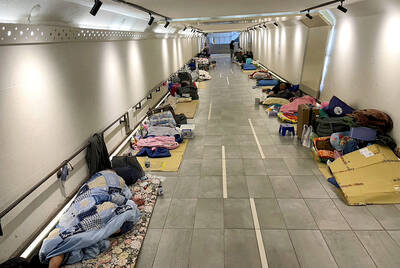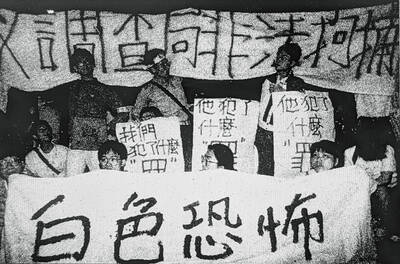At McDonald’s headquarters in Oak Brook, Illinois, is a room employees call “the pulse.” It contains a large television monitor and several computer screens. And this month, it was where the fast-food company’s marketing team and agency partners waited for the Hamburglar.
The classic McDonaldland character had last appeared in a commercial in 2002, but the beef-obsessed bandit was reintroduced on May 6 as part of a new campaign to sell sirloin burgers. Those gathered in “the pulse” that day were there to monitor social media for reaction.
It came almost immediately — and it was decidedly mixed.

Photo: AP
Some on Twitter called the new Hamburglar ads awkward, weird and even creepy. A debate raged after the videos became available online over whether the new Hamburglar was attractive. For McDonald’s, though, the conversation was the point.
“We knew the Hamburglar would obviously create some buzz,” said Joel Yashinsky, vice president for US marketing at McDonald’s. “When we saw it trending on Twitter, we knew we had connected in a way that helped the relevance of the brand.”
RETRO MARKETING

Photo: AP
These are tough times for traditional fast-food restaurants, where sales have faltered in the face of increased competition from fast-casual chains that promise higher-quality ingredients and healthier dining options. So, to set themselves apart in a crowded industry, some fast-food chains are betting on nostalgia.
After McDonald’s resurrected the Hamburglar, the fried chicken chain KFC followed suit. It announced that it was bringing back Colonel Sanders, a white-haired, white-suited character based on the company’s founder, Colonel Harland Sanders.
These back-to-the-future marketing moves come after some years of traditional fast-food companies straying from their core identities. McDonald’s, for instance, recently said it would test kale in a breakfast bowl in some of its Southern California restaurants.
“They want to be a part of American culture but that culture has changed,” Dean Crutchfield, an independent brand consultant, said about big fast-food companies. “In a way, they’ve lost their roots. They need to re-establish themselves.”
By bringing back recognizable characters, McDonald’s and KFC may be trying to remind consumers of a simpler time, Crutchfield added. The companies are also betting that retro characters will appeal to the highly coveted millennial generation that is turning away from traditional fast food in droves.
LIMITS OF NOSTALGIA
Still, looking to the past can be a gamble.
“We have to be careful about nostalgia because it’s difficult to know if nostalgia actually works, especially if you’re looking at a young audience,” Crutchfield said. “I think you can actually alienate a young audience if you’re not careful. Potentially, you’re saying ‘I’m irrelevant.’”
Yashinsky of McDonald’s said that the campaign for sirloin burgers — which features the Hamburglar — was geared toward “the social audience that is on the social sites,” or 18- to 35-year-olds.
Similarly, Kevin Hochman, the chief marketing officer for KFC US, said bringing back Colonel Sanders was intended to “attract the younger customer.” Hochman said the Colonel’s focus was on quality ingredients, his entrepreneurial spirit and his showmanship.
“He’s literally like the ultimate millennial startup,” he said.
KFC has brought on the comedian Darrell Hammond, best known for his impersonations of personalities like Bill Clinton and Donald Trump on Saturday Night Live, to play Colonel Sanders in a series of television commercials that will begin Monday. KFC is also planning to redesign its restaurants.
In a video clip on KFC’s website, Colonel Sanders — who last appeared in a television commercial about 20 years ago — ruminates on how the world is different today.
“Nowadays, you have your international space station, your double-sided tape and your cargo pants,” he says. “But what you don’t always seem to have these days is your Kentucky fried chicken. I’m here to change that, folks.”
JUST ANOTHER GIMMICK?
McDonald’s, which started thinking about bringing back the Hamburglar in January, has re-imagined the burger thief as a grown man with a wife and children. A teaser video, called The Man in Stripes, features a man — wearing a prison-striped apron — flipping burgers on a grill. When he hears on the radio that McDonald’s is introducing sirloin third-pound burgers for a limited time, he drops his spatula. The video ends with the familiar “robble, robble” sounds the original Hamburglar uttered.
In another short clip, the Hamburglar — in a trench coat and fedora — answers repeated phone calls from his wife. At one point, the Hamburglar lies that he is at a party store when he is, in fact, at a McDonald’s. (That ad seemed to fall particularly flat with online commenters.)
“We want to do updates that tie into the historical background of our brand,” Yashinsky said. “We made a conscious effort that we’re not trying to bring back the old positioning of the brand.”
Marketing experts said the re-imagined characters could resonate with today’s consumers.
“Resurrecting a character is well and good — it’s a brand asset,” said Mark Taylor, who helped bring back the king for Burger King about 10 years ago and is the chief creative officer of the agency Energy BBDO. “You can get some mileage out of it. But if you reinvent it, it can be even more effective and more current.”
Still, while the fast-food companies are betting that those marketing experts are correct, some other interested observers are not convinced.
“Why they’re using the Hamburglar again, I have no idea,” said Barry Klein, the former McDonald’s marketing executive who created Ronald McDonald and was behind the other McDonaldland characters. “To me, it’s just another attention-getter. It’s like a gimmick to make people pay attention to the commercial.”

From the last quarter of 2001, research shows that real housing prices nearly tripled (before a 2012 law to enforce housing price registration, researchers tracked a few large real estate firms to estimate housing price behavior). Incomes have not kept pace, though this has not yet led to defaults. Instead, an increasing chunk of household income goes to mortgage payments. This suggests that even if incomes grow, the mortgage squeeze will still make voters feel like their paychecks won’t stretch to cover expenses. The housing price rises in the last two decades are now driving higher rents. The rental market

July 21 to July 27 If the “Taiwan Independence Association” (TIA) incident had happened four years earlier, it probably wouldn’t have caused much of an uproar. But the arrest of four young suspected independence activists in the early hours of May 9, 1991, sparked outrage, with many denouncing it as a return to the White Terror — a time when anyone could be detained for suspected seditious activity. Not only had martial law been lifted in 1987, just days earlier on May 1, the government had abolished the Temporary Provisions Effective During the Period of National Mobilization for Suppression of the Communist

When life gives you trees, make paper. That was one of the first thoughts to cross my mind as I explored what’s now called Chung Hsing Cultural and Creative Park (中興文化創意園區, CHCCP) in Yilan County’s Wujie Township (五結). Northeast Taiwan boasts an abundance of forest resources. Yilan County is home to both Taipingshan National Forest Recreation Area (太平山國家森林遊樂區) — by far the largest reserve of its kind in the country — and Makauy Ecological Park (馬告生態園區, see “Towering trees and a tranquil lake” in the May 13, 2022 edition of this newspaper). So it was inevitable that industrial-scale paper making would

Hualien lawmaker Fu Kun-chi (傅?萁) is the prime target of the recall campaigns. They want to bring him and everything he represents crashing down. This is an existential test for Fu and a critical symbolic test for the campaigners. It is also a crucial test for both the Chinese Nationalist Party (KMT) and a personal one for party Chairman Eric Chu (朱立倫). Why is Fu such a lightning rod? LOCAL LORD At the dawn of the 2020s, Fu, running as an independent candidate, beat incumbent Democratic Progressive Party (DPP) lawmaker Hsiao Bi-khim (蕭美琴) and a KMT candidate to return to the legislature representing